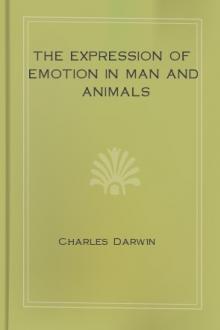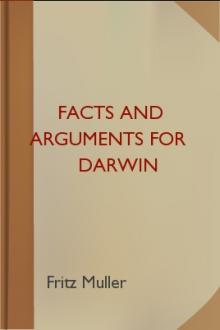The Expression of Emotion in Man and Animals, Charles Darwin [snow like ashes series txt] 📗

- Author: Charles Darwin
- Performer: -
Book online «The Expression of Emotion in Man and Animals, Charles Darwin [snow like ashes series txt] 📗». Author Charles Darwin
Suffering, if great, will from the first have caused screams or groans to be uttered, the body to be contorted, and the teeth to be ground together.
But our progenitors will not have exhibited those highly expressive movements of the features which accompany screaming and crying until their circulatory and respiratory organs, and the muscles surrounding the eyes, had acquired their present structure. The shedding of tears appears to have originated through reflex action from the spasmodic contraction of the eyelids, together perhaps with the eyeballs becoming gorged with blood during the act of screaming. Therefore weeping probably came on rather late in the line of our descent; and this conclusion agrees with the fact that our nearest allies, the anthropomorphous apes, do not weep.
But we must here exercise some caution, for as certain monkeys, which are not closely related to man, weep, this habit might have been developed long ago in a sub-branch of the group from which man is derived.
Our early progenitors, when suffering from grief or anxiety, would not have made their eyebrows oblique, or have drawn down the corners of their mouth, until they had acquired the habit of endeavouring to restrain their screams.
The expression, therefore, of grief and anxiety is eminently human.
Rage will have been expressed at a very early period by threatening or frantic gestures, by the reddening of the skin, and by glaring eyes, but not by frowning. For the habit of frowning seems to have been acquired chiefly from the corrugators being the first muscles to contract round the eyes, whenever during infancy pain, anger, or distress is felt, and there consequently is a near approach to screaming; and partly from a frown serving as a shade in difficult and intent vision.
It seems probable that this shading action would not have become habitual until man had assumed a completely upright position, for monkeys do not frown when exposed to a glaring light. Our early progenitors, when enraged, would probably have exposed their teeth more freely than does man, even when giving full vent to his rage, as with the insane.
We may, also, feel almost certain that they would have protruded their lips, when sulky or disappointed, in a greater degree than is the case with our own children, or even with the children of existing savage races.
Our early progenitors, when indignant or moderately angry, would not have held their heads erect, opened their chests, squared their shoulders, and clenched their fists, until they had acquired the ordinary carriage and upright attitude of man, and had learnt to fight with their fists or clubs.
Until this period had arrived the antithetical gesture of shrugging the shoulders, as a sign of impotence or of patience, would not have been developed. From the same reason astonishment would not then have been expressed by raising the arms with open hands and extended fingers. Nor, judging from the actions of monkeys, would astonishment have been exhibited by a widely opened mouth; but the eyes would have been opened and the eyebrows arched.
Disgust would have been shown at a very early period by movements round the mouth, like those of vomiting,—that is, if the view which I have suggested respecting the source of the expression is correct, namely, that our progenitors had the power, and used it, of voluntarily and quickly rejecting any food from their stomachs which they disliked.
But the more refined manner of showing contempt or disdain, by lowering the eyelids, or turning away the eyes and face, as if the despised person were not worth looking at, would not probably have been acquired until a much later period.
Of all expressions, blushing seems to be the most strictly human; yet it is common to all or nearly all the races of man, whether or not any change of colour is visible in their skin. The relaxation of the small arteries of the surface, on which blushing depends, seems to have primarily resulted from earnest attention directed to the appearance of our own persons, especially of our faces, aided by habit, inheritance, and the ready flow of nerve-force along accustomed channels; and afterwards to have been extended by the power of association to self-attention directed to moral conduct.
It can hardly be doubted that many animals are capable of appreciating beautiful colours and even forms, as is shown by the pains which the individuals of one sex take in displaying their beauty before those of the opposite sex. But it does not seem possible that any animal, until its mental powers had been developed to an equal or nearly equal degree with those of man, would have closely considered and been sensitive about its own personal appearance.
Therefore we may conclude that blushing originated at a very late period in the long line of our descent.
From the various facts just alluded to, and given in the course of this volume, it follows that, if the structure of our organs of respiration and circulation had differed in only a slight degree from the state in which they now exist, most of our expressions would have been wonderfully different.
A very slight change in the course of the arteries and veins which run to the head, would probably have prevented the blood from accumulating in our eyeballs during violent expiration; for this occurs in extremely few quadrupeds. In this case we should not have displayed some of our most characteristic expressions.
If man had breathed water by the aid of external branchiae (though the idea is hardly conceivable), instead of air through his mouth and nostrils, his features would not have expressed his feelings much more efficiently than now do his hands or limbs.
Rage and disgust, however, would still have been shown by movements about the lips and mouth, and the eyes would have become brighter or duller according to the state of the circulation.
If our ears had remained movable, their movements would have been highly expressive, as is the case with all the animals which fight with their teeth; and we may infer that our early progenitors thus fought, as we still uncover the canine tooth on one side when we sneer at or defy any one, and we uncover all our teeth when furiously enraged.
The movements of expression in the face and body, whatever their origin may have been, are in themselves of much importance for our welfare.
They serve as the first means of communication between the mother and her infant; she smiles approval, and thus encourages her child on the right path, or frowns disapproval. We readily perceive sympathy in others by their expression; our sufferings are thus mitigated and our pleasures increased; and mutual good feeling is thus strengthened.
The movements of expression give vividness and energy to our spoken words.
They reveal the thoughts and intentions of others more truly than do words, which may be falsified. Whatever amount of truth the so-called science of physiognomy may contain, appears to depend, as Haller long ago remarked,[4]
on different persons bringing into frequent use different facial muscles, according to their dispositions; the development of these muscles being perhaps thus increased, and the lines or furrows on the face, due to their habitual contraction, being thus rendered deeper and more conspicuous.
The free expression by outward signs of an emotion intensifies it.
On the other hand, the repression, as far as this is possible, of all outward signs softens our emotions.[5] He who gives way to violent gestures will increase his rage; he who does not control the signs of fear will experience fear in a greater degree; and he who remains passive when overwhelmed with grief loses his best chance of recovering elasticity of mind.
These results follow partly from the intimate relation which exists between almost all the emotions and their outward manifestations; and partly from the direct influence of exertion on the heart, and consequently on the brain.
Even the simulation of an emotion tends to arouse it in our minds.
Shakespeare, who from his wonderful knowledge of the human mind ought to be an excellent judge, says:—
Is it not monstrous that this player here, But in a fiction, in a dream of passion, Could force his soul so to his own conceit, That, from her working, all his visage wann’d; Tears in his eyes, distraction in ‘s aspect, A broken voice, and his whole function suiting With forms to his conceit? And all for nothing!
Hamlet, act ii. sc. 2.
[4] Quoted by Moreau, in his edition of Lavater, 1820, tom. iv. p. 211.
We have seen that the study of the theory of expression confirms to a certain limited extent the conclusion that man is derived from some lower animal form, and supports the belief of the specific or sub-specific unity of the several races; but as far as my judgment serves, such confirmation was hardly needed. We have also seen that expression in itself, or the language of the emotions, as it has sometimes been called, is certainly of importance for the welfare of mankind.
To understand, as far as possible, the source or origin of the various expressions which may be hourly seen on the faces of the men around us, not to mention our domesticated animals, ought to possess much interest for us. From these several causes, we may conclude that the philosophy of our subject has well deserved the attention which it has already received from several excellent observers, and that it deserves still further attention, especially from any able physiologist.
[5] Gratiolet (`De la Physionomie,’ 1865, p. 66) insists on the truth of this conclusion.
{raw OCR to the end} INDEX.
ABSTRACTION.
A.
ABSTRACTION, 226.
Actions, reflex, 35 ; coughing,
sneezing, &c., 85; muscular action
of decapitated frog, 36; closing
the eyelids, 38 : starting, 38—
41; contraction of the iris, 41.
Admiration, 289.
Affirmation, signs of. 272.
Albinos, blushing in, 312, 326.
Alison, Professor, 31.
Ambition, 261.
Anatomical drawin,s by HeDle, 5.
Anatomy and Philosophy of Expression,
2.
Anderson, Dr., 106, n. 26.
Anger, as a stimulant, 79; expreqsion,
244; in monkeys, 136. See
also Rage.
Animals, special expressions of, 115.
See al8o Expression.
-7 habitual associated movements
in the lower, 42-49; dogs,
43; wolves and Jackals, 44;
horses, 45; cats, 46; chickens,
4~ , sholdrakes, &c., 48.
Annesley, Lieut., R. A., 124, n. 4.
Antithesis, the principle of, 50 ;
dogs, 50, 57 ; cats, 56; conventional
signs, 61.
Anxie ‘ 17 6,
ty,
Ape, ‘Ile Gibbon, produces musical
the
sou
nds 8
rre
-c
‘tore
A ~s pili, 101, 103.
Association, the power of, 31; instances of, 31, 3 2.
Astonishment, 218; in monkeys.
142.
Audubon, 98, n. 14.
Avarice, 261.
Azara, 126, n. 6,128, n. 7.
B.
Baboon, the Anubis, 95, 133, 137.
Bain, Mr., 8, 31, 198, ‘- 4, 213, n. 21, 290, n. 16,327, n. 25.
BULMER.
Baker, Sir Samuel, 113.
Barber, Mrs., 21, 107, n. 28, 268,
288.
Bartlett, Mr., 44, 48, 112~ 122,134,
136.
Behn, Dr., 310.
Bell, Mr., 293.
-, Sir Charles, 1, 9, 22, 49, 115,
120, 128, n. 8, 144, 157, 171, 210,
n. 17, 218, 220, 304, 336.
Bennett, G., 138, n. 16.
Ber,,eon, 168, n. 21.
BerLrd, Claude, 37, 68, 70, n. 5.
Billiard-player, gestures of the, 6.
Birds ruffle their feathers when
angry. 97; when frightened adpres~
them, 99.
Blair, the Rev. R. IT., 311, 351.
Blind, tendency of the, to blush,
310.
Blushing, 309; inheritance of, 311;
in the various races of man, 315;
movements and gestures which
accompany, 320 ; confusion





Comments (0)